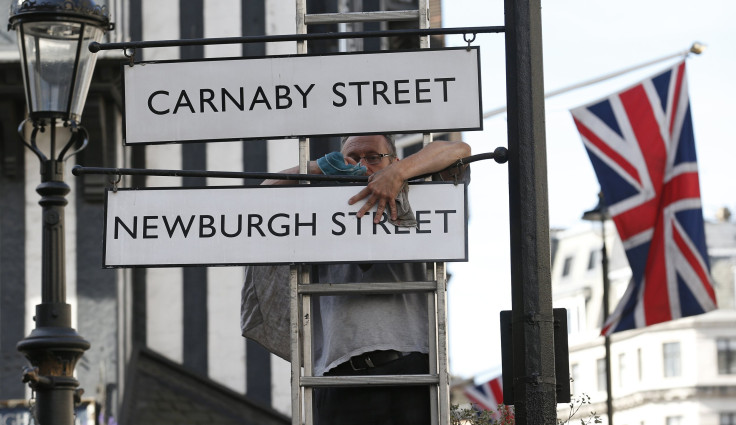UK Payrolls Dropped By 600,000 During March-May, But Jobless Picture Muddled By Wage Subsidy Scheme

KEY POINTS
- The overall U.K. jobless rate remained steady at 3.9%
- The number of job vacancies plunged by 342,000 to 476,000
- 9.1 million workers have now been furloughed in the U.K.
Britain’s workforce was slashed by 612,000 between March and May amid the coronavirus lockdown, while the number of Britons seeking work-related benefits, including unemployment claims, surged by 126% to 2.8 million.
The overall U.K. jobless rate remained steady at 3.9% for the three-month period ended in April – but that was largely due to the government’s massive wage subsidy scheme, said the Office for National Statistics, or ONS.
ONS also noted the total number of weekly hours worked during this period plunged by a record 94.2 million, or 9%, to 959.9 million compared to the prior year.
In addition, the number of job vacancies plunged by 342,000 to 476,000 during the March-to-May period.
"The slowdown in the economy is now visibly hitting the labor market, especially in terms of hours worked," said Jonathan Athow, deputy national statistician for economic statistics at ONS. "Early indicators for May show that the number of employees on payrolls were down over 600,000 compared with March."
Separately, Her Majesty's Revenue and Customs reported that 9.1 million workers have now been furloughed in the U.K. – meaning that more than one quarter of the British workforce has 80% of their monthly wages, up to £2,500 ($3,165), paid for by the government while they are at home.
However, economists warn that the true magnitude of job losses will not become clear until the government wage support programs expire in October.
"It was abundantly clear in every other indicator [other than the headline unemployment rate] that the labor market has weakened dramatically," said Ruth Gregory, senior U.K. Economist at Capital Economics. "Despite the apparent stability of the actual unemployment rate, the labor market data were still pretty awful. And some of this will surely start to filter through into the actual unemployment figures as the government's job furlough scheme is wound down from August."
Tej Parikh, chief economist at the Institute of Directors, concurred: "The furlough scheme continues to hold off the bulk of job losses, but unemployment is likely to surge in the months ahead."
Yael Selfin, chief economist at KPMG U.K., similarly warned that many companies will only bring back a portion of their furloughed workforce back.
"Hiring new workers is also likely to be put on hold for some time," she said.
The Institute of Employment Studies, or IES, a think tank, noted that the claimant count has jumped by 1.6 million since March, a pace comparable to figures from the Great Depression.
The three areas with the highest percentage of people claiming unemployment benefits were Blackpool, the Thanet district in Kent and Birmingham.
"If the public health crisis is just starting to ease, today's figures show that the unemployment crisis is only just beginning,” said Tony Wilson, director of the IES. "It's clear too that this crisis is hitting many poorer areas hardest -- with coastal towns and ex-industrial areas seeing particularly big increases in unemployment."
Several major U.K. employers have already announced major job cuts – on Monday, building supply firm Travis Perkins cut 2,500 jobs. Earlier, British Airways slashed some 12,000 jobs.
Frances O'Grady, secretary-general of the Trades Union Congress, said the labor market was "on red alert.” "We need strong action now to stop lasting economic damage," she said.
The Congress is calling on the government to guarantee jobs for young workers.
“Unemployment will leap if even a small fraction of employers never bring back furloughed workers,” said Samuel Tombs, economist at consultancy Pantheon Economics.
John Philpott, director of The Jobs Economist, a consultancy, grimly noted: “Looking at these figures is like watching the early part of a slow motion video of a car crash, when you already know the horrible outcome but have only witnessed the initial jolt. We know the underlying jobs situation is much worse than this.”
Faisal Islam, BBC economic editor, commented that the furlough scheme is “working in suppressing unemployment and protecting livelihoods so far, [but] the real test of its functioning is what happens now.”
Islam explained that the “real test” will be whether “those jobs remain as the taxpayer wage support is eased away. It requires the government to inject as much confidence as possible, into the minds of employers facing uncertainty and declining bank balances.”
Reuters reported that Prime Minister Boris Johnson ordered a review of Britain’s six-foot social distancing rule as many employers complained this restriction makes it impossible for them to restart their businesses.
But Grant Shapps, transport secretary, indicated that the government is unlikely to suspend the social distancing rule imminently.
“We’re looking at it now. Of course, you know the next stage of the unlock is July 4 at the earliest so there is a bit of time here,” he said.
Johnson and Chancellor of the Exchequer Rishi Sunak apparently may expand a tax incentive for small businesses to encourage the hiring of more workers, and also may suspend social security payments by employers.
© Copyright IBTimes 2025. All rights reserved.





















